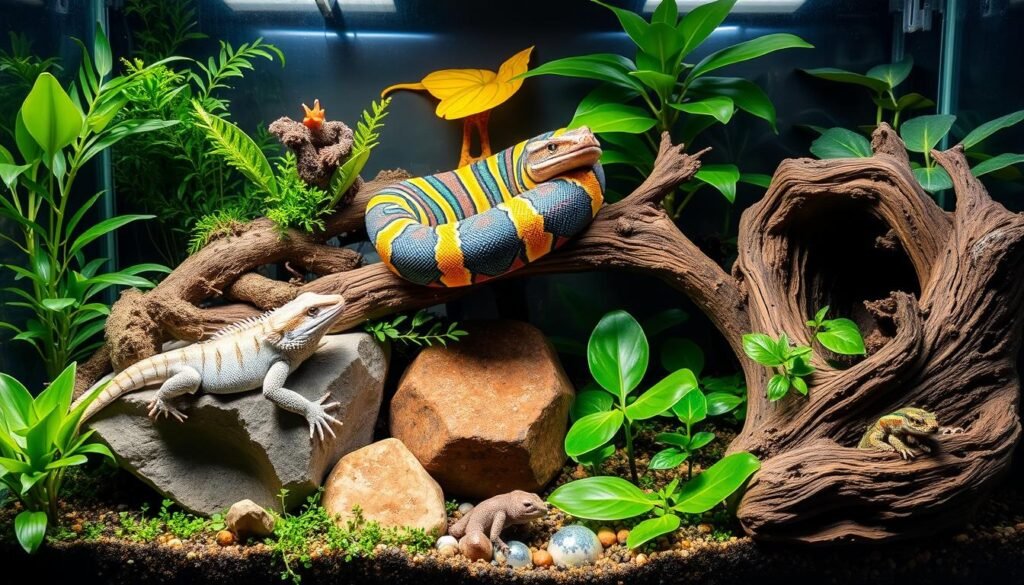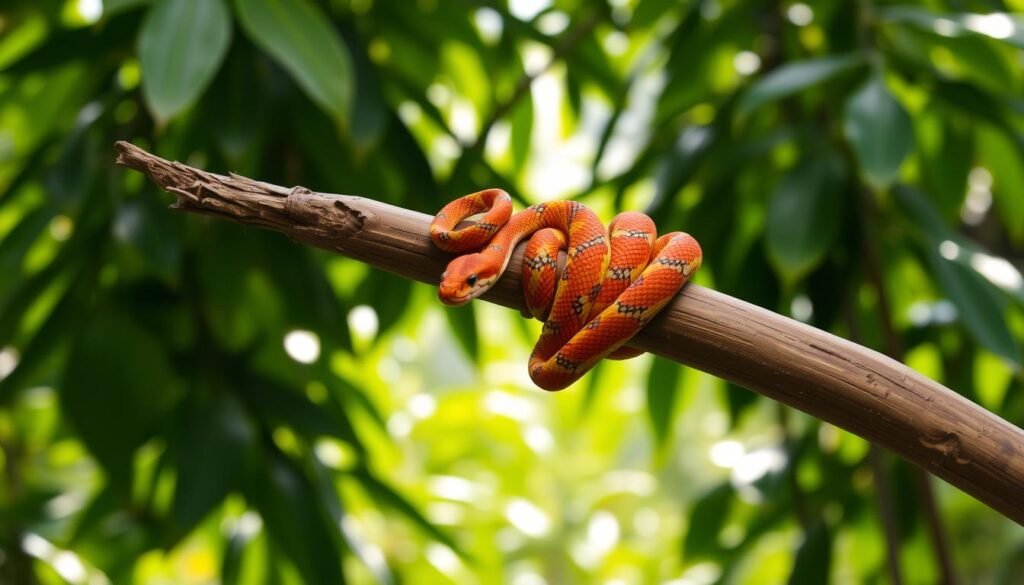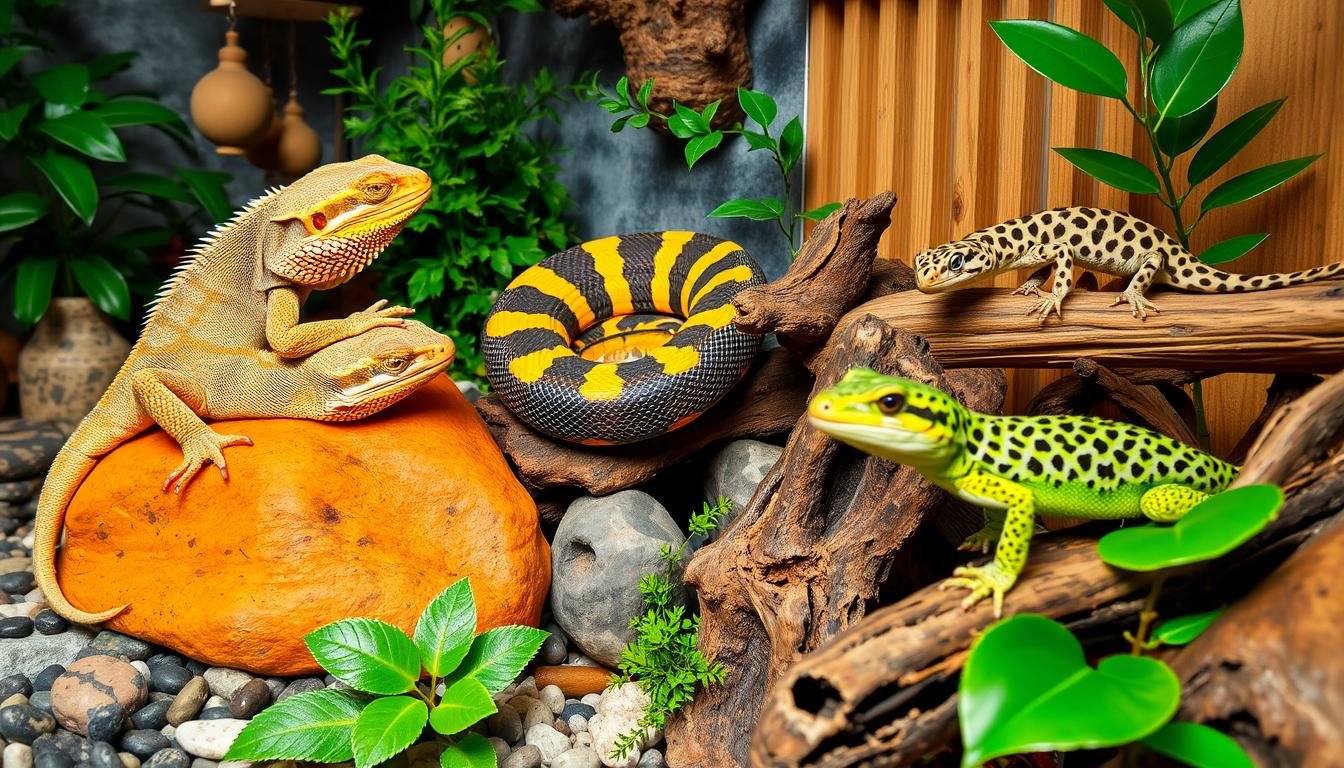Reptiles make great pets, unlike dogs or cats. They come in many types, like the calm leopard gecko and the colorful bearded dragon. These pets are easy to care for and add excitement to your home.
When picking a reptile pet, think about its size, how hardy it is, and how much care it needs. Some popular pets, like leopard geckos, corn snakes, and bearded dragons, are good for beginners. They are easy-going and don’t need a lot of space or care.
Choosing a reptile pet is a big decision. They need special care to stay healthy and happy. Knowing what different reptiles need helps you pick the right one and give it a great home.
Understanding Reptiles as Household Pets
Reptiles make great pets, offering surprises for many. They are perfect for those allergic to fur or feathers because they don’t produce dander. Plus, many reptiles are happy alone, fitting well in small spaces.
Benefits of Keeping Reptiles
Reptiles are easy to care for, needing little attention. They are quiet and interesting, offering lots of learning fun. Some reptiles can live for decades, becoming long-term friends.
Common Misconceptions About Pet Reptiles
- Not all reptiles are dangerous or hard to care for. Bearded dragons and corn snakes are friendly and easy to look after.
- Reptiles don’t need constant attention. They’re happy to be left alone, unlike some other pets.
- The cost of a reptile pet varies. It depends on the species, rarity, and size. With some research, reptile care can be affordable.
What Makes Reptiles Unique Pets
Reptiles come in many shapes, sizes, and colors. This variety lets pet owners find the perfect reptile for them. From geckos’ bright colors to snakes’ movements, reptiles are endlessly fascinating.
Responsible care is key for reptiles’ happiness. By knowing their benefits and debunking myths, owners can enjoy the rewards of reptile care.
Essential Factors to Consider Before Getting a Reptile
Getting a reptile is exciting, but you must think carefully before doing it. You need to know about the reptile’s special traits and the big commitment it requires. Learning about these things can make sure you and your reptile have a great time together.
First, pick the reptile species you want. Reptiles are different in size, behavior, and care needs. For example, bearded dragons are small and easy to care for. But, red-tail boas grow big and need special homes. Knowing the reptile’s adult size, how it acts, and what it needs is key.
Next, think about how much care your reptile needs. Some reptiles need special temperatures and humidity. They also need the right light, like UVB, and a specific diet. You’ll need to learn about these needs to keep your reptile healthy.
| Consideration | Importance | Statistic |
|---|---|---|
| UVB Lighting | Crucial for health and well-being | 67% of reptile and amphibian pet owners cite the need for UVB lighting as a crucial factor |
| Basking Temperature | Critical element in reptile care | 82% of reptile enthusiasts consider basking temperature a critical element |
| Calcium and Vitamin Supplements | Ensure optimal bone growth and neurological health | 50% of reptile keepers supplement their pets’ diets with calcium and vitamin supplements |
Don’t forget the cost of getting and caring for a reptile. The price of the reptile, its habitat, and ongoing care can change a lot. Some reptiles, like tortoises, live a long time. So, you must be ready to care for your reptile for its whole life.
Thinking about these important points can help you decide if getting a reptile is right for you. With the right research and planning, you can start a fun journey of reptile ownership. You’ll be able to give your new reptile the care and home it needs.
Types of Reptiles Suitable as Pets

Choosing a pet reptile can be overwhelming. But, with the right info, you can find the perfect scaly friend. There are options for all experience levels and lifestyles.
Beginner-Friendly Species
For new reptile owners, leopard geckos, corn snakes, and bearded dragons are great. They are easy to care for and have calm temperaments. Leopard geckos can live up to 20 years and need simple care.
Corn snakes are also popular. They live about 20 years and are easy to care for. They are known for their calm nature.
Intermediate Level Species
As you get more experience, you might want crested geckos, ball pythons, or skinks. These need more specialized care but are rewarding pets. Crested geckos live up to 20 years and need a humid terrarium.
Ball pythons live 20-30 years and need careful temperature and humidity control. They are a great choice for those who are dedicated to their care.
Advanced Care Species
For experienced reptile lovers, chameleons, green iguanas, or monitor lizards are interesting. They need specialized care and equipment. Chameleons, for example, require precise temperature and lighting controls.
It’s important to research any reptile you’re interested in. Make sure you can provide the right care and environment. This way, you and your reptile can have a rewarding experience together.
Leopard Geckos: The Perfect Starter Reptile
Leopard geckos are great for those new to reptiles. They have cool spots and are easy to care for. They are perfect for beginners because they are calm and not too big.
Leopard geckos grow to 7 to 11 inches long. They need a 10-gallon tank each. Their tank should have UVB lighting, a heat pad, and a hide box. They also need food and water bowls and a good substrate.
They eat live insects like crickets and mealworms. It’s important to dust their food with calcium and vitamins.
Leopard geckos are very calm. They are active at dawn and dusk. This makes them safe for families with kids, as long as someone watches them.
They can live up to 20 years with the right care. This shows how important it is to keep their habitat clean and stable.
In summary, leopard geckos are great for beginners. They are easy to care for, calm, and can live a long time. They are a wonderful choice for anyone looking to add a reptile to their home.
“Leopard geckos are the perfect starter reptile for those new to the hobby. Their calm temperament and relatively simple care requirements make them an excellent choice for first-time reptile owners.”
Bearded Dragons: Popular Family Companions
Bearded dragons are a favorite among reptile pets. They are loved for their calm nature and fun personalities. These Australian natives can live up to 15 years with the right care.
Personality Traits
Bearded dragons are friendly and gentle, perfect for new reptile owners. They love being held and show cute behaviors like waving and bobbing their heads. They are active during the day, making them great pets.
Care Requirements
Bearded dragons need a good home to stay healthy. They do best in a 55-75 gallon tank with the right heat, light, and bedding. Their tank must be warm and dry to meet their needs.
Diet and Feeding Schedule
- Young bearded dragons eat once or twice a day, while adults eat once a day.
- They need a mix of insects, veggies, and fruits for a balanced diet.
- It’s important to give them calcium and vitamins for their health.
Bearded dragons are a hit with families for their unique charm and easy care. With the right care, they can become cherished family pets.
Corn Snakes: Docile and Low-Maintenance

Looking for a captivating yet low-maintenance reptile? Consider the corn snake. These docile and adaptable snakes are popular among reptile lovers. Their vibrant colors, calm nature, and simple care make them great for beginners.
Corn snakes, known as Elaphe guttata, grow 2.5 to 4 feet long. Some can reach up to 6 feet. They live 15 to 20 years, making them a rewarding long-term pet.
One reason corn snakes are beginner-friendly is their calm nature. These pet snake species are easy to handle and less likely to defend themselves. They’re perfect for first-time snake owners or families with kids.
When it comes to corn snake care, they have simple needs. They need a 30-gallon tank with secure lids to prevent escapes. The snake habitat should be 80 to 85 degrees Fahrenheit, with a basking spot at 85 to 88 degrees. Humidity should be between 35% and 60% for healthy shedding.
Feeding corn snakes is easy. They eat pre-killed frozen mice that are thawed. Hatchlings start with pinkie mice, growing to larger prey as they get bigger. Young snakes eat twice a week, while adults eat once a week or every two weeks.
In summary, corn snakes are a great choice for a low-maintenance pet snake species. Their calm nature, manageable care, and vibrant colors make them a popular and rewarding reptilian companion.
“Corn snakes are often considered one of the best snake species for beginners, as they are generally docile, easy to care for, and readily available in the pet trade.”
Creating the Ideal Habitat Setup
Creating the perfect home for your reptile pet is key to their health. The enclosure should be big enough, at least 1.5 times the animal’s length and depth. Turtles need tanks or ponds, snakes like terrariums, and lizards prefer enclosures or terrariums.
Temperature Control
Keeping the right temperature is crucial for reptiles. They need a range of 20 to 30°C for their daily activities. Make sure there’s a warm spot and a cooler area for your pet to regulate their body temperature.
Lighting Requirements
Good lighting is essential for reptiles, especially UVB lighting for bone health. Many reptiles, like lizards, need UVB to make vitamin D3 and absorb calcium. Use the right lighting to match their natural day-night cycle.
Substrate Choices
The bedding in the enclosure is important for a healthy home. Choose the right substrate to avoid health issues. Options include bark chips, sand mixes, or soil, based on the reptile’s natural habitat. Textured mats are also good for easy cleaning and visibility.
Adding hiding spots, climbing structures, and enrichment elements will make your reptile feel safe and happy. Regular cleaning and watching your pet are key to their well-being.
| Habitat Element | Recommendations |
|---|---|
| Enclosure Type |
|
| Enclosure Size | At least 1.5 times the length and depth of the reptile |
| Temperature | Maintain between 20-30°C for daily activities |
| Lighting | Provide appropriate UVB lighting for vitamin D3 and calcium absorption |
| Substrate |
|
| Enrichment |
|
By carefully setting up the perfect habitat, you can make sure your reptile pet thrives and enjoys a healthy, fulfilling life.
Nutrition and Feeding Guidelines
Keeping your reptile healthy starts with a good reptile diet. Different reptiles need different foods. Knowing what they eat is key to keeping them balanced and healthy.
Snakes, being carnivorous, love to eat pre-killed mice or rats. These give them the protein and fat they need. Bearded dragons, on the other hand, eat a mix of insects, veggies, and fruits. Tortoises stick to plants, like leafy greens and flowers.
Many reptiles also need calcium and vitamin D3 to stay healthy. Remember, how often you feed them can change. Some need food every day, while others eat less often.
| Nutrient | Dry Matter (%) | Protein (%) | Fat (%) | Energy (Kcal/g) | Calcium (%) | Phosphorus (%) | Ca:P Ratio |
|---|---|---|---|---|---|---|---|
| Mice (Frozen/Thawed) | 25-30 | 55-65 | 15-20 | 4.5-5.0 | 0.3-0.6 | 0.5-1.0 | 0.5-1.5 |
| Dubia Roaches | 30-35 | 20-25 | 5-10 | 4.5-5.0 | 0.2-0.3 | 0.4-0.6 | 0.5-1.0 |
| Crickets | 25-30 | 20-25 | 5-10 | 5.0-5.5 | 0.2-0.3 | 0.4-0.6 | 0.5-1.0 |
Offering a varied reptile diet is key. It keeps your pet healthy, active, and happy.
Health Care and Veterinary Needs
Keeping pet reptiles healthy is key. They often hide signs of illness until it’s too late. Regular vet visits are crucial for catching problems early, like parasites and bone diseases.
Common Health Issues
Reptiles face many health issues, such as skin infections and digestive problems. Signs of illness can be hard to spot until it’s serious. Quick vet visits are essential.
Preventive Care Measures
- Provide a proper, well-maintained habitat with appropriate temperature, humidity, and lighting.
- Feed a balanced, nutritious diet tailored to the specific species.
- Conduct regular health checks and fecal tests to monitor for parasites or other issues.
- Seek veterinary care at least annually, or more often if any concerns arise.
Finding a Reptile Veterinarian
Finding a vet who knows reptiles is vital. They can do detailed exams and tests. They also give specific treatment plans for reptile health issues. Quick vet visits are key if your reptile gets sick or hurt.
“Reptiles require daily attention, including handling, observation, and care, to ensure their well-being and early disease detection.”
Handling and Socialization Techniques
Handling and socializing pet reptiles is key. Start with short, gentle handling and increase time as they get used to it. Bearded dragons and leopard geckos often enjoy human interaction. Snakes, on the other hand, may tolerate handling but don’t always seek it out.
When handling reptiles, support their body gently and avoid sudden movements. This helps them not to become skittish around people. Regular, gentle handling helps reptiles get used to humans and builds a bond with their owners.
Reptile Handling Recommendations
- Spend at least 15 minutes a day handling reptiles to promote healthy socialization.
- Terrariums with easy-to-open sliding or hinged doors are preferred over traditional screen tops for housing reptiles.
- The Reptile Comfort Leash by T-Rex is suitable for securing iguanas, geckos, monitors, anoles, and tegus during handling.
- Products like climbing vines, ladders, and hammocks enhance interaction between owners and their reptiles.
Socialization Methods for Reptiles
- Geckos, bearded dragons, red-eared sliders, and ball pythons are recommended for socialization due to their docile nature.
- For intractable snakes, using proper tools like a snake hook or snake tongs is a safe and effective handling method.
- Socializing a snake can take anywhere from 1 to 6 months or longer, with a minimum of 3 days a week with 1 session each day lasting 10 to 30 minutes.
- The socialization process involves gradually increasing handling time and comfort level, with the final stage marking the completion when the snake shows no nervous behavioral signs.
Taming Techniques for Reptiles
| Technique | Suitable Species | Benefits |
|---|---|---|
| Jumping Hand-to-Hand | Crested Geckos | Allows for exercise and bonding |
| Deli Cup Capture | Skittish Reptiles and Amphibians | Minimizes stress on the animals |
| Herping | Experienced Enthusiasts | Allows for observing reptiles in their natural habitat |
Handling and socializing reptiles needs patience, gentleness, and understanding of their needs. By following these best practices, you can help your reptile pet feel more comfortable and build a strong bond with you.
Long-Term Care Commitments
Owning a reptile is a big responsibility that should not be taken lightly. Many reptiles, like tortoises, can live for 50 to 100 years or more. Snakes and lizards may live for 20 to 30 years. Owners must be ready to care for their reptile for its whole life, which could be longer than theirs.
Keeping a reptile’s habitat clean, changing its diet, and watching its health are key parts of reptile care. Owners need to spend time, effort, and possibly a lot of money on vet bills. If they don’t, their reptile could get sick or die early.
Reptiles need special homes, lights, and temperature control. As they get older, their care needs change. Owners must adjust their pet’s home and food to meet these changes. If they don’t, their reptile might get stressed, sick, or live a shorter life.
“Reptiles are a long-term commitment, and prospective owners need to be prepared to care for their pets for decades to come. Proper planning and a genuine understanding of the responsibilities involved are essential for ensuring the reptile’s well-being and a successful pet-owner relationship.”
Before getting a reptile, think about the long-term care it needs. Make sure you have the time, money, and commitment to give it the best care for its whole life. Being a responsible reptile owner means more than just the initial excitement of getting a pet.
Conclusion
Reptiles can be amazing pets for those ready to care for them. They range from easy-to-keep pets like leopard geckos and corn snakes to more challenging ones like water dragons. Each reptile has its own needs, so it’s important to do your research and commit to caring for them long-term.
Thinking about getting an exotic pet? You should look into their lifespan, habitat needs, diet, and vet care. With the right care and dedication, reptiles can be wonderful, low-maintenance friends that add joy and interest to your life.
Whether you’re new to reptiles or have experience with exotic pets, it’s vital to think about your lifestyle and what you can handle. By learning about the different reptiles and their needs, you can find a pet that fits your life and brings you happiness for years to come.
FAQ
What are some popular reptile pets?
Popular reptile pets include leopard geckos, corn snakes, and bearded dragons. Also, crested geckos, tortoises, and ball pythons are favorites.
What factors should be considered when choosing a pet reptile?
When picking a reptile, think about the species, size, and hardiness. Also, consider maintenance needs, cost, and how long they live.
What are the benefits of keeping reptiles as pets?
Reptiles are low-maintenance and fit well in small spaces. They often have fewer health issues than other pets. They offer a unique and fascinating pet experience.
What are some common misconceptions about pet reptiles?
Many think all reptiles are dangerous or hard to care for. But, many species are docile and easy to care for, perfect for beginners.
What makes reptiles unique as pets?
Reptiles are unique because of their diverse species and varied appearances. Their fascinating behaviors make them great for learning and enjoyment.
What are some beginner-friendly reptile species?
Beginner-friendly reptiles include leopard geckos, corn snakes, and bearded dragons. They are known for being easy to care for and gentle.
What are the care requirements for leopard geckos?
Leopard geckos need a 10-gallon tank, UVB lighting, and a heat pad. They also need a hide box, suitable substrate, and a diet of insects. They are peaceful and can live up to 20 years with proper care.
What are the key care needs for bearded dragons?
Bearded dragons need a 4x4x2 feet enclosure, UVB lighting, and proper heating. They also need a varied diet of insects, vegetables, and fruits. They are friendly and can be handled by children under supervision.
How do corn snakes differ from other pet snakes?
Corn snakes are docile and easy to handle, making them great for beginners. They need a 30-gallon tank, a temperature gradient, and a diet of pre-killed mice. Young snakes are fed every 7-10 days, and adults every two weeks.
What are the essential elements for creating an ideal reptile habitat?
An ideal habitat includes the right enclosure size, temperature control, and UVB lighting. Suitable substrate and decorations like hides and rocks also provide enrichment and mimic natural habitats.
How do reptile diets vary by species?
Reptile diets vary widely. Carnivorous species eat mainly meat, while omnivorous species need a mix of insects, vegetables, and fruits. Herbivorous species need a plant-based diet. Many reptiles also need calcium and vitamin supplements.
Why is regular veterinary care important for reptiles?
Regular veterinary care is key for reptile health. It helps monitor for common issues like parasites and metabolic bone disease. Finding an experienced reptile veterinarian is essential.
How important is handling and socialization for pet reptiles?
Handling and socialization are crucial for many reptiles. They help prevent them from becoming skittish around people. Start with short, gentle handling sessions and gradually increase duration.
What are the long-term commitments involved in reptile ownership?
Reptiles have long lifespans, requiring a significant commitment from owners. Owners must be prepared for consistent care, potential veterinary costs, and proper housing for decades.













